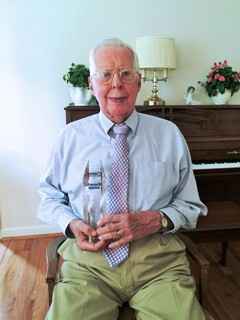Russell Smith
2015 Lifetime Achievement Award Recipient
 Where Innovation and Tradition Converge
Where Innovation and Tradition Converge
Russell Smith Receives 2015
IADD Lifetime Achievement Award
Editor’s note: The following was taken from IADD President Darrel Griffin’s remarks at the Awards Banquet, May 14, at the 2015 IADD•FSEA Odyssey in Schaumburg, IL, USA.
This year’s Odyssey theme is “where innovation and tradition converge,” and that actually very accurately describes our recipient, Russell L. Smith.
In 1961, Ward Machinery came up with a new concept in the corrugated converting industry which was soft anvil rotary diecutting. Russ played an integral part in bringing it to where it is today. But before I get into those details, let me start way back in the beginning.
Russell was born in the suburb of Riverside on the west side of Cincinnati, OH, USA in 1924, which makes him a member of the Greatest Generation. But he wasn’t just a player by default—he was a true member of that generation. When Russ graduated high school, he went straight down to the US Army recruiter’s office to enlist to serve in World War II, but they wouldn’t take him because he was only 17. So he had to wait until he was 18; and when that time came around, he was ready to go and he enlisted in the US Army. He took what is equivalent to today’s ASVAB (Armed Services Vocational Aptitude Battery) aptitude test and he scored so well that he could choose whichever branch he wanted to serve in. He chose the US Army Air Corps (this was before the Air Force had separated from the Army), where he became a cartographer, which is a mapmaker. If you think about being a mapmaker in this day and age, we use the GPS on our phones, but back then in the mid-1940s, they used equipment that I couldn’t even identify right now. He served in India, about 60 miles (97 mk) north of Calcutta and made maps for use in Burma. I mention this because—and I’ve experienced this myself when I was in the Army—sometimes you would deploy somewhere and your equipment wouldn’t show up. Being a mapmaker, they had to have equipment to do their job, so he and one of his buddies had to develop an apparatus called a restitutional photo/printer, which became his first invention. That ingenuity was a prelude to the brilliance of the man who we are honoring here tonight.
After he was discharged from the service, he went back home to Cincinnati, where he earned a BS in mechanical engineering at the University of Cincinnati and then went on to Xavier to get his MBA. Shortly after that he went into the workforce and became involved in the corrugated container industry. He found himself at Mead Container, and his overall duty was to improve the process of the corrugated container division. As part of this, he was involved in the negotiations for the purchase of equipment, and a lot of the equipment he purchased was from Ward Machinery.
Around 1962, Bill Ward was developing a new concept in corrugated diecutting—the soft anvil rotary process. The pioneers in this field included the converters and diemakers who actually put the new technology to use. There were few industry standards and only some basic diemaking and diecutting materials and equipment available. The process of soft anvil diecutting was on a slow evolutionary process of improvement.
At the time, Russ Smith was an engineer at Mead Container. Bill Ward was impressed with his work and invited Russ to come over and work at the Ward Machinery Company starting in 1976 as a Technical Engineer. One of Russ’s first assignments was to solve the dimensional stability issue associated with soft anvil rotary diecutting. Russ went to work on the problem and developed a solution—one that is still in use today, 40 years later.
In 1962, flat-bed corrugated diecutting used 0.937" (23.8 mm) cutting rule. Bill Ward designed his early soft anvil rotary diecutter to use 0.937" (23.8 mm) rule. Russ determined that the creasing rules in the cutting die controlled the sheet speed through the diecutter—not the cutting rule as was originally imagined. He determined that the cutting rules should be increased to 0.970" (24.6 mm) height to allow for higher creasing rules to then sync the sheet speed with the cutting press speed of rotation.
Russ describes his job at the time as simply representing the customer to the engineers at Ward; he would go out and listen to the customers, work with them, evaluate how they were using the machinery, determine what changes they might need that would improve their operations, etc. As a mechanical engineer, he was able to translate that to the engineers in a language that they would understand.
Russ went on to develop all the modern standards for soft anvil rotary die-cutting. These included knife and crease heights for many common stocks, rubbering guidelines, package design improvements for better rotary diecutting and effective treatments for scrap waste removal. All this information was compiled into a specification manual in the late 1970s that became the industry standard for soft anvil rotary diecutting.
Russ’s ideas and creative approach resulted in many such important discoveries and modifications throughout the years. Throughout this process, Russ was influential in developing many original ideas that became Ward patents—to this day it is said that Russ’s DNA is in every rotary diecutter.
Although he was known as an inventor and process engineer, Russ’s primary function and achievement has really been as an educator. When Russ retired from Ward in 1985, he continued to be a major influence in the industry worldwide, traveling to any die shop or converter who requested his assistance to better understand the soft anvil process. He became the industry guru for soft anvil diecutting. He generously gave his time as a speaker at numerous educational and technical programs and was a prolific writer. His specification manual became the textbook for all his training sessions. Today, key players in the soft anvil rotary industry continue to cite Russ’s teachings in their own educational programs, and many of his publications are still used as procedural bibles. Some are currently housed in the US Library of Congress.
Russ grew close to the diemaking/diecutting industry as a result of all the training he was providing. He became active in the IADD and TAPPI, and served in many roles for each, including President of TAPPI’s Corrugated Container Division (1975) as well as the IADD President from 1985-1987. He continued to support and attend other industry events and organizations such as TAPPI and AICC long after his tenure at Mead Container and Ward Machinery. In the true sense of tradition converging with innovation, Russ’s technical charts and content are still used by others to educate industry members worldwide, and many say that his DNA is found in almost all of the machinery used in soft anvil diecutting today.
While Russ will admit that his best effort in publication was his book, Improving the Performance of Printing and Rotary Die Cutting in the Making of Corrugated Boxes, what struck me most in talking with him and others who know him is that despite all of his many and varied accomplishments, Russ is a very humble man. While most people who receive an award are thankful and honored, it occurred to me in this case that it is really the IADD who is honored to be able to give an award to such a venerable pioneer who developed a multitude of standards that didn’t exist at the time. It’s hard to fathom how one individual could have laid down the foundation for everything we take for granted in soft anvil rotary diemaking and diecutting today, but that’s what Russ did. In the 1970s, he laid the foundation for soft anvil diecutting and diemaking that we still stand upon today.
Russ is now 92 years old and still influencing us. Since he couldn’t be with us on the night of this award—on which he was also celebrating his 66th wedding anniversary with wife Mitzi—we asked Steve Biller of MarquipWardUnited to accept the award on his behalf and to say a few words about Russ. Steve shared:
I was fortunate to have had an opportunity to work with Russ. Russ was a passionate teacher and educator; in just about any photo you’ll find of Russ, he’s showing somebody something. He was a master at sharing his knowledge; and now those he taught are the teachers. His influence is so widespread that when word of this award got out at MarquipWardUnited, congratulations poured in from everyone, because even those who never met him know who Russ is. As Darrel aptly stated, Russ’s DNA is in pretty much all the equipment that goes out of the doors of all the rotary diecutting manufacturers in the world. His core technology still exists somewhere in those products.
Russ has meant a lot to me professionally, so I’d like to share one story. It was January 4, 1999, and I had left the company I had been with my entire life, a good company where I had left behind friends, family, etc. I arrived at Ward in this big building with a lot of people who are a lot smarter than me; I’m handed my emergency medical kit and escorted to meet people in the engineering department, which was more than a little intimidating. When I get to my office, my phone rings and I’m wondering who it could be since no one even knows I’m here yet. It’s Russ Smith and he says, “Hey Steve, you started 10 years to the day I retired. I’m thrilled you’re there. They couldn’t have picked a better person.”
That call coming from Russ meant a lot to me. That was the kind of guy he was, always making sure that the people he taught could go on. Over the years, we shared presentations, stories and I even kept him up to date with the latest Ward shirts with all the company logos. I am honored, humbled and very proud to know Russ and to accept this award on his behalf.
In addition to the IADD Lifetime Achievement Award, Russ will also receive a special plaque put together by associates at MarquipWardUnited which sports an original Ward logo and the inscription:
All of the associates at MarquipWardUnited express deep gratitude in recognizing Russ Smith for the many years dedicated to The Ward Machinery Company and the countless devoted hours contributed to our organization. The innovations of Russ continue to be present in the equipment we build today. Thank you Russ from all your friends!
See past Lifetime Acheivement awardees—and other IADD honorees—online here.

